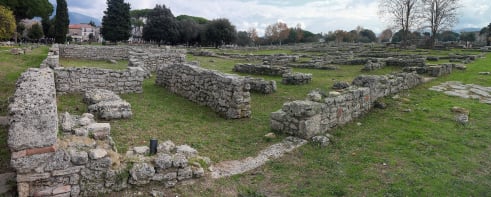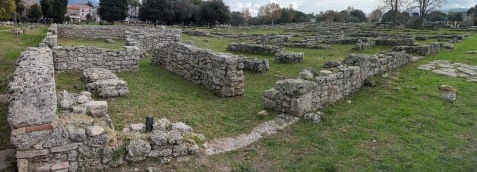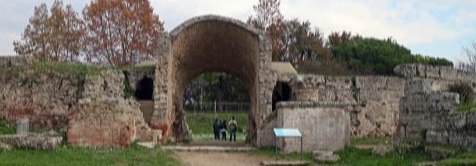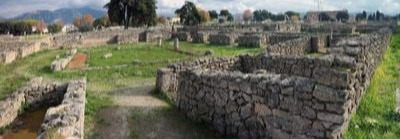Scavi
Scavi Paestum Paistos. Tempio Italico ' Bona Mens ', costruito intorno al 273 a.C.', Via Sacra lunga circa 9 chilometri. la Via Sacra univa la città di Poseidonia al più antico tempio di Hera, edificato nei pressi del fiume Sele., situato in origine alla foce del fiume Sele. Il santuario è ora a circa 1,5 km dal mare, per il deposito dei terreni alluvionali portati dal fiume Sele.. L'anfiteatro della Paestum romana fu costruito intorno al 50 a.C. Casa con impluvio. L'Ekklesiasterion o Bouleutèrion, monumento fondamentale dell'agora. Si tratta di un edificio di forma circolare con gradinate concentriche, tagliate direttamente nel banco roccioso e poi rivestite di blocchi. La struttura è datata al 480/470 a.C.
"Excavations Paestum Paistos". Italic Temple 'Bona Mens', built around 273 BC,' Via Sacra about 9 km long. the Via Sacra linked the city of Poseidonia to the oldest temple of Hera, built near the Sele river, originally located at the mouth of the Sele river. The sanctuary is now about 1.5 km from the sea, for the storage of alluvial soils brought by the river Sele. The Roman Paestum amphitheater was built around 50 BC. House with impluvium. The Ekklesiasterion or Bouleutèrion, fundamental monument of the agora. It is a circular building with concentric steps, cut directly into the rocky bank and then covered with blocks. The structure is dated back to 480/470 b.C.
Tomba del Tuffatore
La Tomba detta del Tuffatore , trovata nel 1968, illustra la pittura greca verso il 480 a.C. I pezzi di inestimabile valore storico e artistico sono conservati nel museo. Sacello (Heroon) a Paestum, è un piccolo edificio sotterraneo greco del VI-V sec a.c. Il Foro fu costruito dopo il 273 a.C., nella parte meridionale, che era stata l'antica agora; era il centro politico, religioso e sociale. Nel 273 a. C., Paestum subì numerose trasformazioni urbanistiche, abitazioni del periodo romano, Casa con " impluvio in marmo ". Il Foro, ImIl Foro fu costruito dopo il 273 a.C., nella parte meridionale, che era stata l'antica agora; era il centro politico, religioso e socialepluvium.
The Tuffatore tomb, found in 1968, illustrates Greek painting around 480 BC. The pieces of inestimable historical and artistic value are preserved in the museum. Sacello (Heroon) in Paestum, is a small underground Greek building from the 6th-5th century BC. The Forum was built after 273 BC, in the southern part, which had been the ancient agora; it was the political, religious and social center. In 273 a. C., Paestum underwent numerous urban changes, houses from the Roman period, house with "marble impluvium". Il Foro, ImIl Foro was built after 273 BC, in the southern part, which had been the ancient agora; it was the political, religious and social center pluvium.
Templi
Il Tempio di Atena o tempio di Cerereo Atena (circa 500 a.C.), costruito circa cinquant'anni prima del Tempio di Nettuno è costituito da tredici colonne sui lati lunghi e sei sui brevi, con ampio portico antistante la cella . Il Tempio di Nettuno o Poseidone (metà del V sec a.C.) - Viene considerato come l'esempio più perfetto dell'architettura dorica templare in Italia e in Grecia. Basilica, di ordine dorico con diciotto colonne sui lati lunghi e nove sui corti. La cella, che è preceduta da un portico, è divisa in due navate da una fila di colonne. Basilica, il più antico, di ordine dorico con diciotto colonne sui lati lunghi e nove sui corti.
The Temple of Atena or temple of Ceres or Athena (about 500 BC), built about fifty years before the Temple of Neptune, consists of thirteen columns on the long sides and six on the short ones, with a large porch in front of the cell. The Temple of Neptune or Poseidon (mid-5th century BC) - It is considered to be the most perfect example of Doric Templar architecture in Italy and Greece. Basilica, of Doric order with eighteen columns on the long sides and nine on the short ones. The cell, which is preceded by a portico, is divided into two naves by a row of columns. Basilica, the oldest, of Doric order with eighteen columns on the long sides and nine on the short ones.
Photo Panoramiche HD
Foto Panoramiche di Paestum Paistos o Posidonia fondata, secondo Strabone, dagli Achei di Sibari come centro commerciale marittimo al principio del 6° sec. a.C.
La fotografia panoramica è una tecnica che si basa sull’unione di più scatti per ottenere una grande ed estesa immagine. Il processo di unire le singole fotografie in un unico scatto viene chiamato “stitching”.
Panoramic Photos of Paestum Paistos or Posidonia founded, according to Strabo, by the Achaeans of Sybaris as a maritime commercial center at the beginning of the 6th century.
Panoramic photography is a technique that is based on combining multiple shots to obtain a large, extended image. The process of joining individual photographs into a single shot is called “stitching”.








